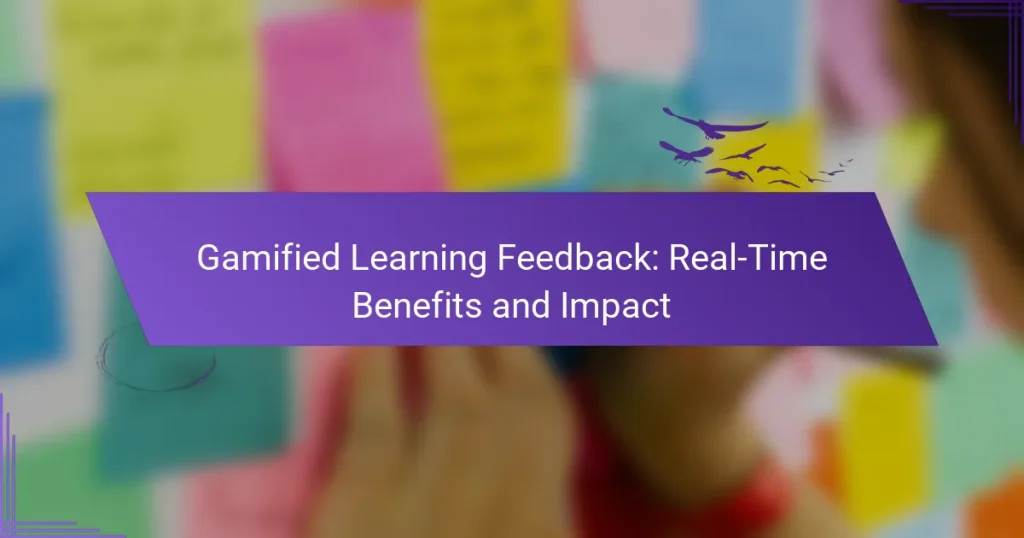Gamified learning feedback revolutionizes online education by incorporating game-like elements that foster active engagement and provide immediate insights into student performance. This innovative approach not only enhances the enjoyment of the learning experience but also promotes better knowledge retention and motivation, allowing learners to adapt their strategies based on real-time feedback.

How does gamified learning feedback enhance online courses?
Gamified learning feedback enhances online courses by integrating game-like elements that promote active participation and immediate response. This approach not only makes learning more enjoyable but also provides valuable insights into student performance in real-time.
Increased engagement through interactive elements
Interactive elements, such as quizzes, polls, and simulations, significantly boost engagement in online courses. By incorporating these features, learners are more likely to participate actively rather than passively consuming content.
For example, a course might include a leaderboard that ranks students based on quiz scores, fostering a sense of competition. This competitive aspect can lead to increased interaction and collaboration among peers.
Immediate performance insights for learners
Gamified learning provides immediate feedback on performance, allowing learners to understand their strengths and weaknesses right away. This instant feedback loop helps students adjust their study strategies effectively.
For instance, after completing a module, a learner might receive a score along with specific areas for improvement. This direct insight encourages timely adjustments, enhancing overall learning outcomes.
Motivation boost via rewards and challenges
Incorporating rewards and challenges into online courses serves as a powerful motivator for learners. Badges, points, and certificates can incentivize students to complete tasks and engage with the material more deeply.
Challenges, such as time-limited quizzes or skill-based competitions, can further stimulate interest and participation. Setting achievable goals and offering tangible rewards can lead to higher completion rates and a more fulfilling learning experience.
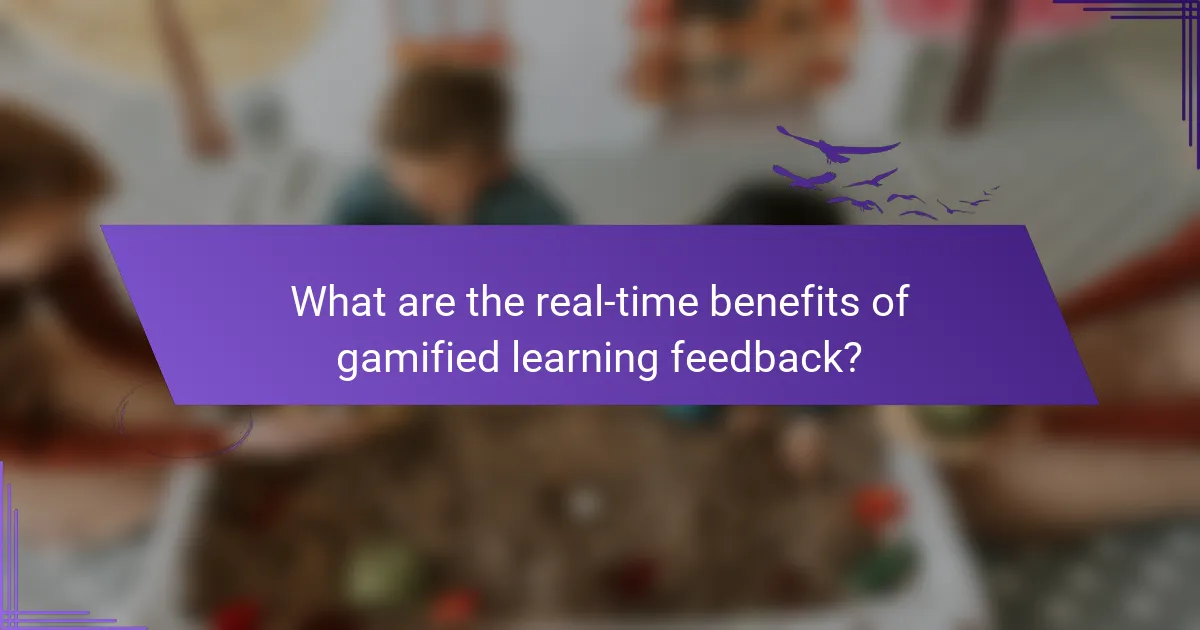
What are the real-time benefits of gamified learning feedback?
Gamified learning feedback provides immediate insights into a learner’s progress, enhancing engagement and knowledge retention. By integrating game-like elements, this approach motivates users to actively participate and adapt their learning strategies based on real-time feedback.
Instant feedback loops improve retention
Instant feedback loops are crucial in gamified learning as they allow learners to receive immediate responses to their actions. This real-time information helps reinforce concepts and correct misunderstandings promptly, leading to better retention of knowledge.
For example, when a student answers a question correctly, they might receive points or badges instantly, which not only validates their effort but also encourages them to continue learning. Studies suggest that immediate feedback can improve retention rates by significant margins, often exceeding traditional methods.
Adaptive learning paths based on user performance
Adaptive learning paths tailor educational content to the individual learner’s performance, ensuring that they are neither bored nor overwhelmed. By analyzing user interactions and outcomes, these systems can adjust the difficulty and type of content presented, optimizing the learning experience.
For instance, if a learner struggles with a particular topic, the system may provide additional resources or simpler tasks before advancing. This personalized approach not only enhances understanding but also keeps learners motivated by presenting challenges that are appropriate for their skill level.
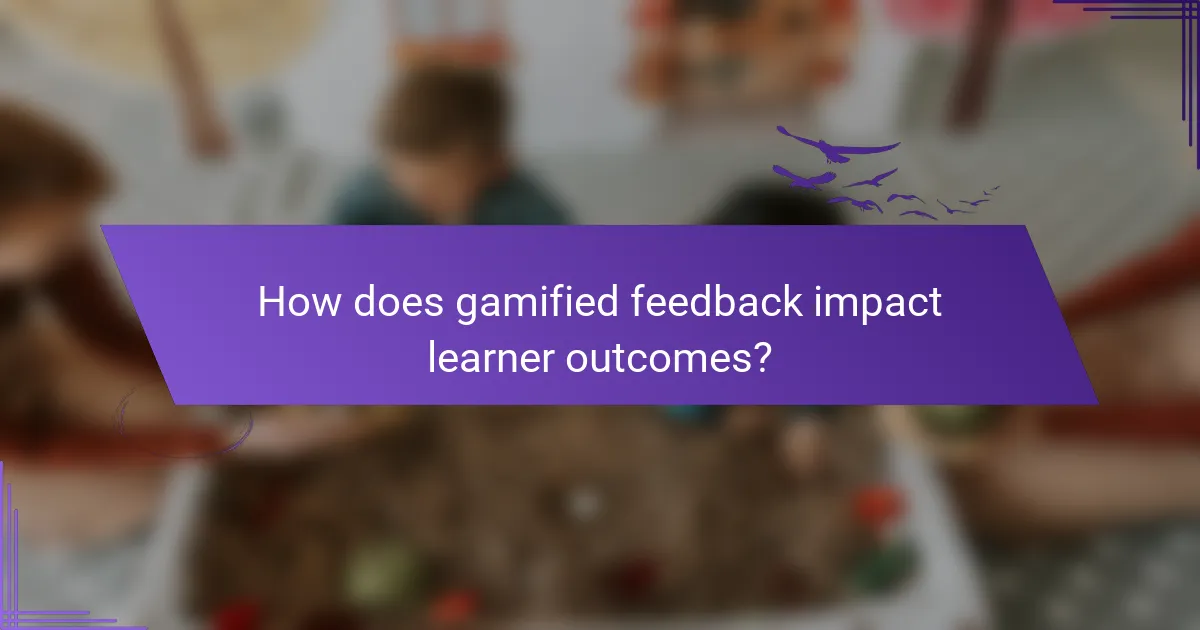
How does gamified feedback impact learner outcomes?
Gamified feedback significantly enhances learner outcomes by increasing engagement and motivation. By incorporating game-like elements, learners receive immediate responses to their actions, which fosters a more interactive and effective learning environment.
Higher completion rates in online courses
Gamified feedback can lead to higher completion rates in online courses by making the learning process more enjoyable and rewarding. When learners receive instant feedback, they are more likely to stay engaged and motivated to finish the course.
For example, platforms that use badges, points, or leaderboards can encourage learners to progress through the material. Studies suggest that courses with gamified elements can see completion rates increase by 20-30% compared to traditional formats.
Enhanced critical thinking and problem-solving skills
Gamified feedback promotes enhanced critical thinking and problem-solving skills by presenting learners with challenges that require active engagement. As learners navigate through tasks, they must analyze situations, make decisions, and adapt their strategies based on immediate feedback.
Incorporating scenarios that mimic real-world problems can help learners develop these skills effectively. For instance, simulations or role-playing games can provide a safe space for learners to experiment and learn from their mistakes, ultimately leading to improved analytical abilities.
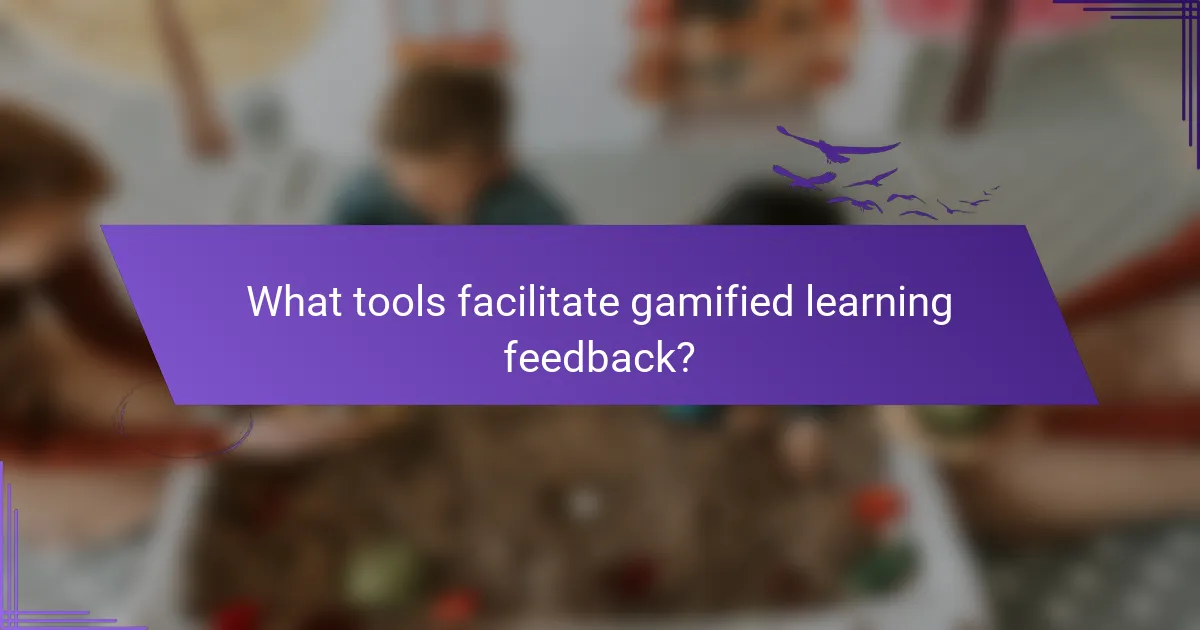
What tools facilitate gamified learning feedback?
Several tools enhance gamified learning feedback by providing interactive and engaging platforms for students. These tools allow for real-time assessment and feedback, making the learning process more dynamic and effective.
Kahoot! for interactive quizzes
Kahoot! is a popular platform that enables educators to create interactive quizzes that engage students in a fun way. Users can participate in quizzes via their smartphones or computers, allowing for instant feedback and competitive learning experiences.
To maximize effectiveness, educators should design quizzes that align with learning objectives and ensure questions vary in difficulty. This approach keeps students challenged and motivated, enhancing their learning outcomes.
Consider using Kahoot! for formative assessments, as it provides immediate insights into student understanding. This can help identify areas needing reinforcement before moving on to new material.
Classcraft for immersive experiences
Classcraft transforms the classroom into an immersive learning environment by integrating game mechanics into educational activities. Students create avatars and earn rewards for positive behavior and academic achievements, fostering a sense of community and collaboration.
To implement Classcraft effectively, teachers should set clear goals and rules, ensuring that students understand how their actions impact their progress. Regularly updating challenges and quests keeps the experience fresh and engaging.
Utilizing Classcraft can lead to improved student motivation and participation, but it requires consistent monitoring and feedback to maintain engagement levels. Educators should be prepared to adapt the game elements based on student responses and performance.

What are the prerequisites for implementing gamified feedback?
To successfully implement gamified feedback, organizations need to understand their learners’ demographics and preferences, as well as integrate suitable technology platforms. These prerequisites ensure that the gamified approach is engaging and effective in enhancing the learning experience.
Understanding learner demographics and preferences
Recognizing the demographics of your learners is crucial for tailoring gamified feedback effectively. Consider factors such as age, educational background, and cultural context, as these elements influence how learners interact with gamified systems.
Additionally, understanding preferences, such as whether learners enjoy competitive elements or collaborative tasks, can guide the design of feedback mechanisms. Surveys or focus groups can provide insights into these preferences, helping to create a more personalized learning environment.
Integrating technology platforms effectively
Choosing the right technology platforms is essential for delivering gamified feedback. Platforms should support interactive elements like quizzes, leaderboards, and instant feedback features, which enhance engagement and motivation.
When integrating these technologies, ensure they are user-friendly and accessible across devices. Consider compatibility with existing learning management systems (LMS) to streamline the implementation process and avoid potential disruptions in the learning experience.
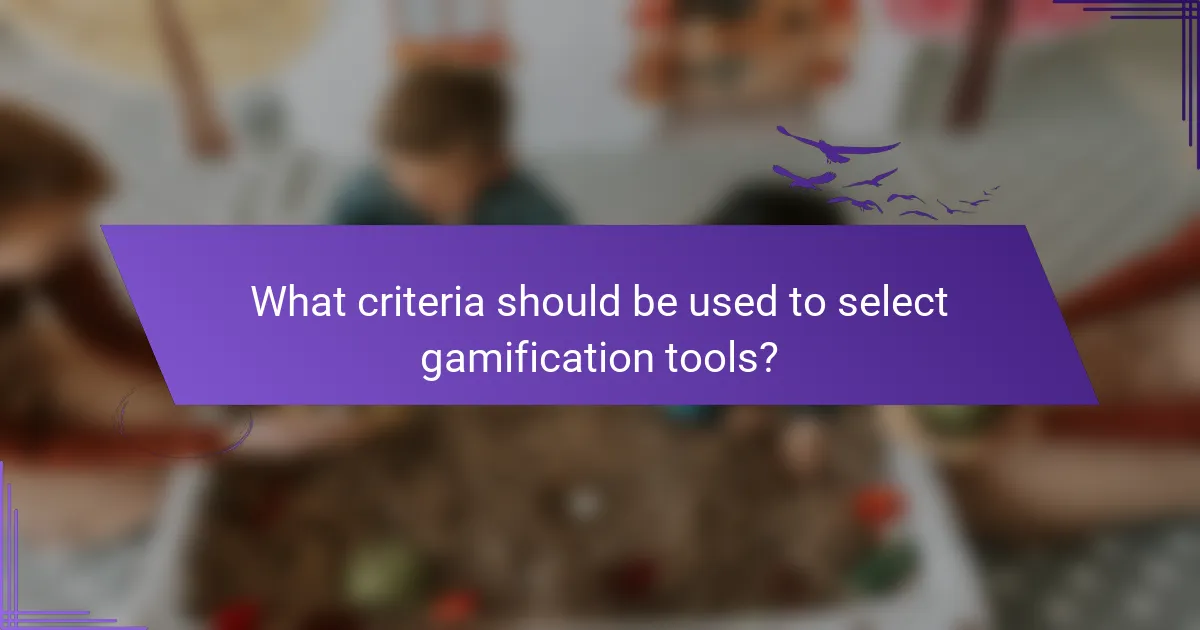
What criteria should be used to select gamification tools?
Selecting gamification tools requires careful consideration of usability, analytics, and engagement features. The right tools should enhance the learning experience while providing instructors with the necessary insights to track progress effectively.
User-friendly interface for instructors
A user-friendly interface is crucial for instructors to navigate gamification tools easily. Look for platforms that offer intuitive dashboards, simple navigation, and clear instructions to minimize the learning curve. Tools that allow customization of the interface can also enhance usability.
Consider platforms that provide drag-and-drop features or templates, which can save time and effort in setting up learning modules. A good user experience can lead to higher adoption rates among educators and better engagement with students.
Analytics capabilities for tracking progress
Effective analytics capabilities are essential for tracking student progress in gamified learning environments. Choose tools that offer real-time data on student performance, engagement levels, and completion rates. This information can help instructors identify areas where students may be struggling.
Look for features like customizable reports and visual data representations, which can make it easier to interpret results. Additionally, ensure that the analytics comply with relevant educational standards and privacy regulations to protect student data.
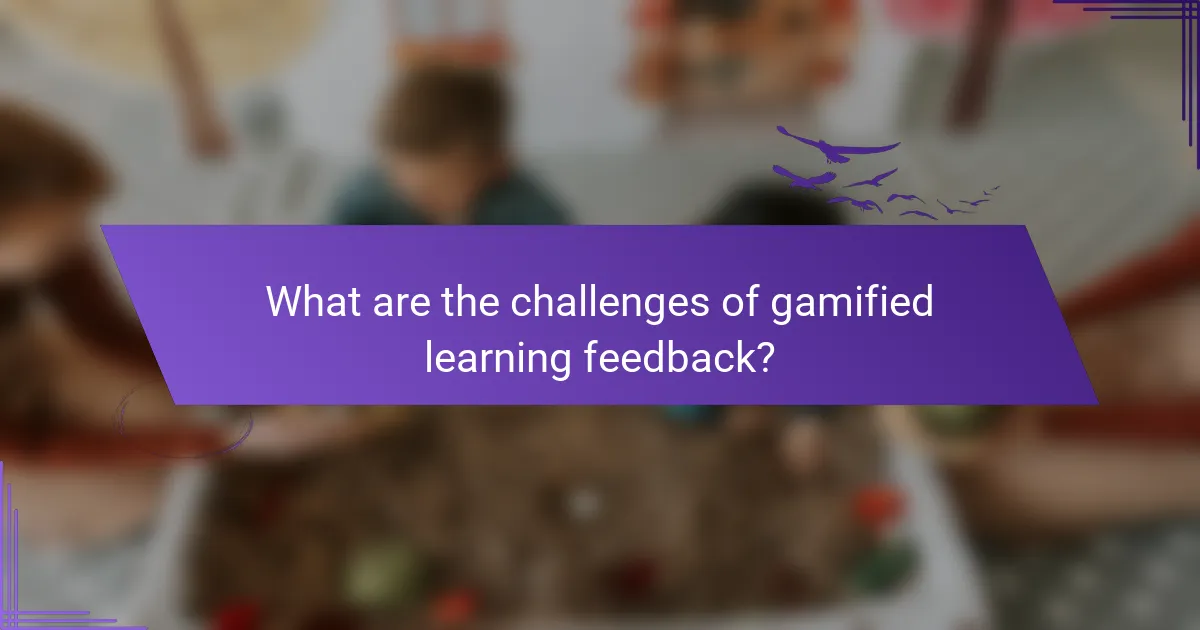
What are the challenges of gamified learning feedback?
Gamified learning feedback can enhance engagement but also presents several challenges. Key issues include potential distractions, varying learner motivations, and the risk of superficial learning if not implemented thoughtfully.
Potential for distraction among learners
Gamified elements, such as points, badges, and leaderboards, can sometimes distract learners from the core educational content. When students focus more on achieving rewards than on mastering material, their overall learning experience may suffer.
To mitigate this distraction, educators should ensure that gamification is aligned with learning objectives. For instance, integrating feedback mechanisms that emphasize skill mastery rather than just point accumulation can help maintain focus on educational goals.
Additionally, setting clear guidelines on how to engage with gamified elements can prevent learners from becoming sidetracked. Regular check-ins and discussions about the purpose of these features can reinforce their educational value and keep students on track.
